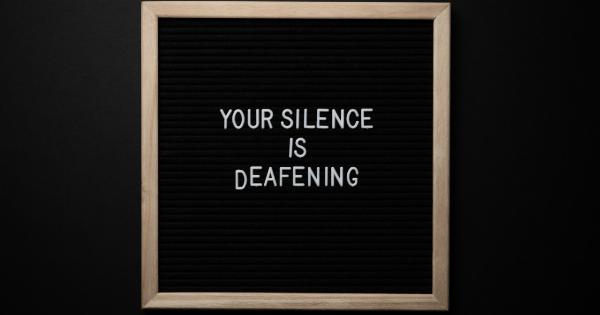Dehydration occurs when the body loses more fluids than it takes in. It is a common condition that can happen to anyone, especially those who are not drinking enough water or experiencing excessive sweating.
Recognizing the signs of dehydration is crucial for maintaining good health and preventing complications.
Signs of Dehydration
1. Dry mouth and increased thirst:.
One of the earliest signs of dehydration is a dry mouth. When the body lacks fluids, the saliva production decreases, resulting in a parched sensation. Increased thirst is also a common symptom, as the body tries to compensate for the fluid loss.
2. Fatigue and dizziness:.
Dehydration can cause fatigue and feelings of exhaustion. When there is not enough water in the body, it affects the normal functioning of organs and cells, leading to decreased energy levels.
Dizziness and lightheadedness can also occur due to low blood pressure resulting from dehydration.
3. Dark urine:.
Monitoring urine color is an essential indicator of hydration levels. Dark yellow or amber-colored urine usually signifies dehydration. In a well-hydrated body, urine is pale yellow or clear.
4. Decreased urine output:.
People who are dehydrated may notice a decrease in urine output. This occurs because the body tries to preserve fluids by reducing the amount of urine produced. Decreased urine output is a sign that the body is conserving water for vital functions.
5. Dry skin and lips:.
A lack of hydration affects the largest organ of the body, the skin. Dehydration can cause dry, flaky, or cracked skin, particularly in areas such as the lips.
Dry skin is a result of the body redirecting water to more essential organs to maintain their function.
6. Muscle cramps:.
Muscle cramps can be a sign of dehydration, particularly during physical activity or in hot weather. When the body lacks fluids and essential electrolytes like potassium and sodium, muscles are more prone to cramping and spasms.
7. Rapid heartbeat:.
Dehydration can speed up the heart rate. When the body lacks fluids, the volume of blood decreases, leading to an increase in heart rate. This is the body’s way of compensating for less fluid in circulation.
8. Headaches and migraines:.
Headaches are a common symptom of dehydration. The loss of fluids affects the brain’s moisture levels, leading to headaches or even migraines in severe cases. Staying hydrated can help reduce the frequency and intensity of headaches.
9. Confusion and irritability:.
Severe dehydration can affect the brain, leading to confusion, irritability, and difficulty concentrating.
The brain relies on adequate hydration to function optimally, so any imbalance in fluid levels can have a significant impact on cognitive abilities.
10. Sunken eyes and dry tear ducts:.
In cases of severe dehydration, the eyes may appear sunken, and tear ducts may become dry. These signs occur because the body prioritizes maintaining fluid levels in essential organs, often resulting in visible effects around the eyes.
Preventing Dehydration
Prevention is key when it comes to dehydration. Here are some tips to help you stay hydrated:.
1. Drink enough water:.
The most obvious way to prevent dehydration is to drink enough water throughout the day. The recommended daily intake varies depending on factors such as age, activity level, and climate.
However, a general guideline is to drink at least eight glasses of water each day.
2. Be mindful of caffeine and alcohol consumption:.
Caffeine and alcohol act as diuretics and can increase fluid loss. While moderate consumption is generally okay, it’s essential to drink extra water to compensate for the dehydrating effects of these substances.
3. Consider your environment:.
If you live in a hot climate or are spending time in a hot or humid environment, it’s crucial to increase your fluid intake. Sweating can quickly deplete fluids, so ensure you stay hydrated by drinking water regularly.
4. Eat hydrating foods:.
Many fruits and vegetables have high water content and can contribute to your hydration. Foods like watermelon, cucumbers, and oranges are excellent choices to incorporate into your diet to maintain proper hydration levels.
5. Monitor urine color:.
Monitoring the color of your urine is a simple and effective way to assess hydration. Ensure that your urine is pale yellow or clear, indicating adequate hydration. Dark-colored urine is a sign that you need to drink more water.
6. Take breaks during physical activity:.
If you engage in intense physical activity or exercise, take regular breaks to drink water and rehydrate. Sweating causes fluid loss, so replacing the lost fluids is crucial to avoid dehydration.
7. Pay attention to early signs:.
Recognizing the early signs of dehydration is vital. If you feel thirsty or notice any of the symptoms mentioned earlier, don’t ignore them.
It’s best to address dehydration early on to prevent it from worsening and causing potential complications.
Seeking Medical Help
If you are experiencing severe dehydration or symptoms that worsen despite taking preventive measures, it’s essential to seek medical help.
In some cases, oral rehydration solutions or intravenous fluids may be necessary to restore proper hydration levels.
Dehydration can be particularly dangerous for infants, young children, and older adults. These age groups are more vulnerable to fluid imbalances and may require medical attention sooner.
Remember, prevention is always better than cure when it comes to dehydration. By staying mindful of your fluid intake and recognizing the signs of dehydration, you can maintain good hydration levels and keep your body functioning optimally.































